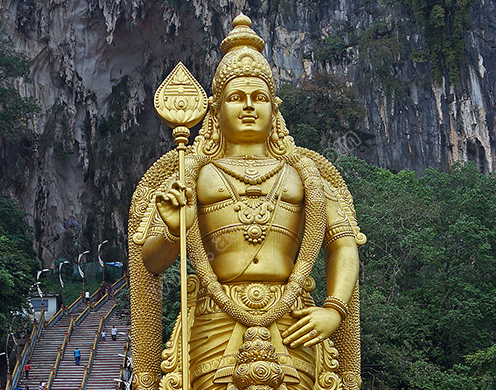

A great scholar of his time, he was well educated in various fields.

The origin of Tamil language is associated with the legend of Sage Agathiyar who lived in the area that is now modern day Gujarat thousands of years prior to the start of Kali Yuga. His Shanmata system also propagated this idea. Worship of Karthikeyan as the son of Lord Shiva was a practice of the formal religious sect called Koumaram, sanctified by Sri Shankaracharya. The depiction of Lord Muruga travelling on the peacock signifies the purging of one’s ego. The bird is known for its unpredictable behaviour and symbolizes ego, which often leads to erratic behaviour. Culturally the peacock is the vehicle of Subramanya. The weapon of Vel in the hand of Karthikeyan is also a deity in itself and is considered to be the tool that will wipe out ignorance. The notable aspect of this is that the iron representation of the Vel and rooster have been found in the ancient graves of Aticcanallur – an extensive prehistoric burial place in Tamil Nadu that is roughly 7,000 years old. Other works of the Sangam era that mention Murugan include Akananuru, Paripaatal and Purananuru.Īrchaeological findings of pottery from various areas of Tamil Nadu have shown ideographic inscriptions of a brave warrior who is capable of killing demons as early as 3rd century BC. Tamil Nadu was divided by the writers of the era into five allegorical areas or tinai and poets believed that the presiding deity of the Kurinci region was Murugan. As mentioned before, this is believed to be a description of Lord Murugan. They have poems exclusively written in praise of Chevvel or The Red One. The best literary works according to scholars on Murugan are the Thirumurukattruppadai and Paripaatal. This could be proof that the God was popular in the culture of Tamil Nadu much before his mention in literature. It is further mentioned that Murugan is the favourite God of the Tamils. A work in Sangam Literature known as Tolkappiyam glorifies Murugan as the young and resplendent red god who is seated on a peacock. Lord Muruga is said to have presided over the second Sangam called Idai Sangam when the capital of the kingdom was shifted to Kabaadapuram in Kanyakumari.

The Pandya Kings contributed to the development of Tamil language by creating many Sangams or groups. The process of worship of the deity also included a form of dance called Veriyaattu, which is still practised. It is a name that later got ascribed to the deity himself.

Further, there are mentions about a priest with the name Velan who is associated with this deity. A deity named Murugu or nature spirit is described to be worshipped with ritualistic sacrifices. The earliest account of Murugan is perhaps from the Tamil Sangam literature, which dates back to 300 BC. The faces symbolize the five senses and the mind working in harmony. Another name of Muruga is Shanmukha which means having six faces. So, his name is symbolic of the three major forces of nature according to Tamil mythology. Mu stands for Mukundan or Vishnu, Ru stands for Rudra or Shiva and Ka stands for Kamalan or Brahma. There is also another reason why he is named Muruga or Muruka. Since, the God is considered to be a manifestation of handsomeness and masculinity, he was aptly named Murugan. The word Murugu literally means divine, youthful, fragrant etc. The answer to this can be found if we take a quick glance at the literature, archaeological remains and popular legends prevalent in Tamil Nadu. It sometimes makes people wonder why this particular God is held on a pedestal among the other Gods in Hinduism. He is worshipped with great fervour throughout the state and also in some parts of Kerala and Malaysia. Lord Murugan or Karthikeyan is an extremely popular God in Tamil Nadu.


 0 kommentar(er)
0 kommentar(er)
